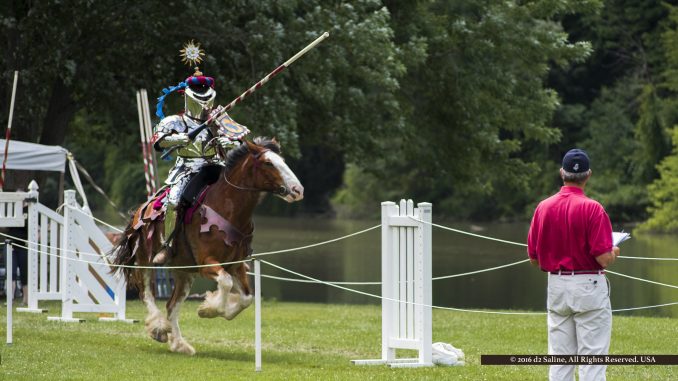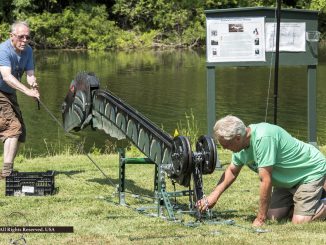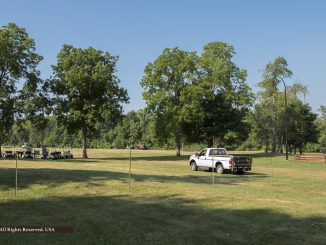
Commonly referred to a “jousting,” these competitions are as much a part of Saline Celtic Festival tradition as any kilt, clan, or dance. Maybe you’ve watched competitions from start to finish, cheered favorites and applauded wins. But like any spectator, you want to know more — from history and rules, to strategy and advanced scoring. [1,2]
The first recorded tournament dates to the year 1066. [3]
Jousting and other forms of weapons training can be traced back to the Middle Ages and the rise of the use of the heavy cavalry (armored warriors on horseback) — the primary battlefield weapons of the day. The feudal system then in place required rich landowners and nobles to provide knights to fight for their king during war. Jousting provided these knights with practical, hands-on preparation in horsemanship, accuracy and combat simulations that kept them in fighting shape between battles. However, what was initially intended purely as military training quickly became a form of popular entertainment.
Take the word “entertainment” with a grain of salt. Henry VIII, suffered serious injury in a 1524 joust during his tenure as King of England and almost died. In 1559, King Henry II of France was killed while jousting for sport. [4,5,6]
Moreover, a full suit of armor could weigh up to one hundred pounds. Additionally, the effort required to move in such a configuration is well in excess of that required to carry similar weight in a backpack. One study found that knights “used 2.1 to 2.3 times more energy walking with their armor on compared to with walking without it. Running with armor took 1.9 times the energy as running armor-free.” [7]
The Metropolitan Museum of Art has provided answers to more than a dozen of its most frequently asked questions about Medieval armor. Armor must be custom made and the middle range cost for this is around $7,000. Add another $4,500 for the horse. At that point the ongoing expenses of supplies, travel, practices, and participation begin. [8,9]
In 2012, The History Channel aired a reality TV series titled Full Metal Jousting and it is frequently cited as the most accurate contemporary reflection of what those original events must have been like. A video providing solid introduction to their sequencing, equipment, and scoring is available on YouTube. The key to earning points is for one horseman to strike with his lance the gridded grandguard on the chest of his opponent. Lance diameters can be varied to scale up or down the impact they are capable of delivering on any given run. [10,11]
As emphased every year when Saline Celtic Festival jousts are introduced, among the worst things any participant can do is mistreat a horse. To do so will result in that player being removed from the competition — and perhaps being banned entirely from future involvement in the sport.
Hard core jousters would characterize what you’ll see in Mill Pond Park as something more commonly seen at “Rennaissance fairs” as opposed to Full Metal Jousting. But there’s no question that the participants you’ll see in the three shows scheduled for July 14 are true athletes playing in authentic, unscripted competitions for real wins and losses. Now consider yourself even better prepared for these battles.
References
- Saline Celtic Festival (home page).
- “Living History / Jousting” Saline Celtic Festival.
- “History of Jousting” History.
- “Henry VIII’s 1524 Jousting Accident by Sara Bryson” Claire Ridgeway (2016) The Tudor Society.
- “The jousting accident that turned Henry VIII into a tyrant” Michael McCarthy (April 18, 2009) Independent.
- “Jouster killed in freak accident when shattered lance spears him through the eye during Time team re-enactment” Andy Dolan (January 27, 2011) The Daily Mail.
- “Heavy Metal: Armor Drained Medieval Knights’ Energy” Stephanie Pappas (July 19, 2011) Live Science.
- “Arms and Armor—Common Misconceptions and Frequently Asked Questions” The Met.
- “Real jousting a hard-hitting — and painful — sport” Amanda Neufeld (September 26, 2005) Chicago Tribune.
- “Full Metal Jousting” IMDb.
- “Full Metal Jousting – The Rules of the Joust | History” History (February 19, 2012) YouTube.



